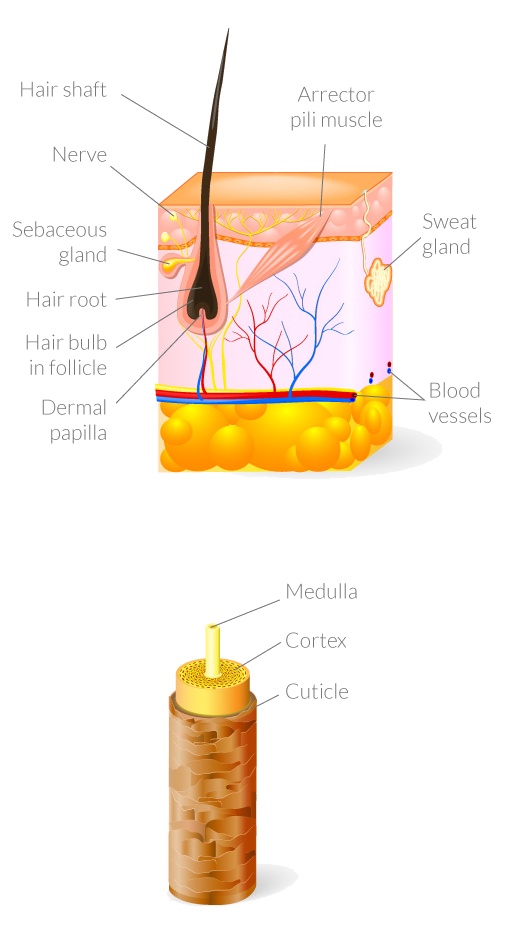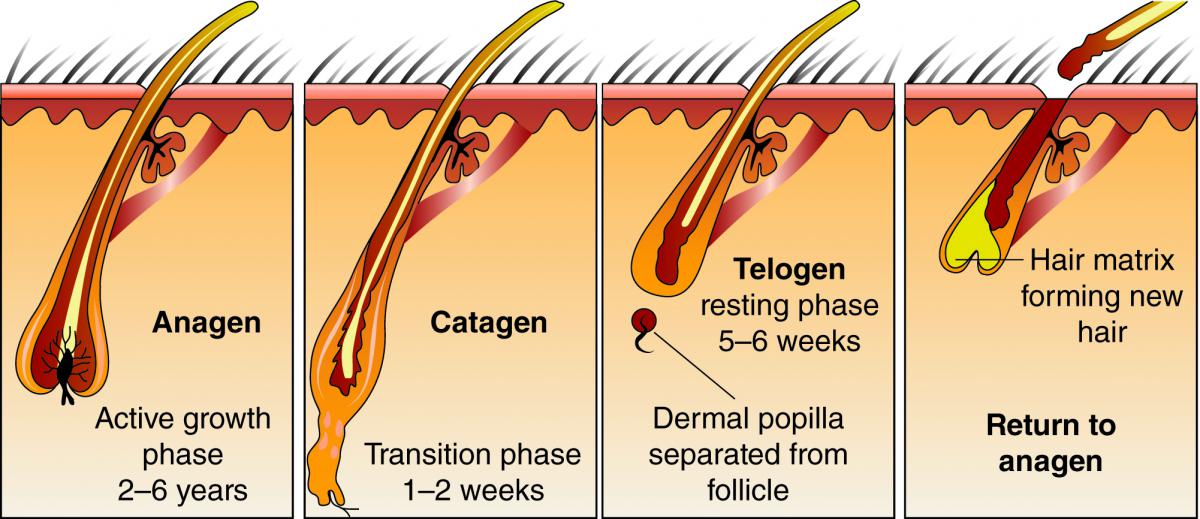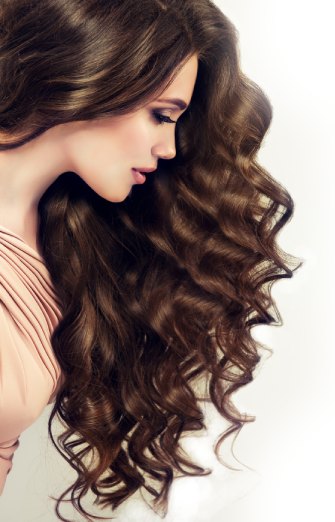
THE HAIR ANATOMY
Each hair consists of a root – the part of the hair which is located deep within the skin, and shaft – the part visible on the surface (that which we call our “hair”). In the hair shaft can be found three concentric layers: 1. Extermal layer, or the cuticle. It is also called outer or scale. 2. The cortex. 3. The medullar layer – the central, inner substance.
The medullar substance of hair
This is the central part of the hair shaft, which is not found in all types of human hair. For example, in baby hair the medulla is absent. The medullar substance is replaced by air bubbles, due to which the hair attains some degree of thermal conduction. The medulla plays no role in changing the chemical or physical qualities of the hair.
The hair cuticle
The hair cuticle performs a protective, barrier function. It forms in 6-10 overlapping layers of transparent keratin plates, interconnected by many cross bonds and lipid layers. The cuticle interfaces mechanical and chemical influences on the hair. An undamaged cuticle reflects light well. The hair shines and does not break.
Core substance (cortex)
Cortex – the main substance of hair (constitutes 70-85% or hair volume) which is made up of thousands of keratin strands. These fibers are twisted between themselves and connected by strong cross links. Each hair follicle is an independent formation, with its own growth cycle, and these cycles are not synchronized between different follicles. Otherwise, we would lose all our hair at the same time, while in reality this process takes place gradually and unnoticeably. Each hair follicle has its own nerve system and musculature. Due to muscles and nerve endings, the hair follicle acquires tactile sensitivity, which allows it to complete barely perceptible movements. You have probably already heard that hair is a nonliving substance, capable of self-regeneration. Living cells, which multiply with great speed, exist in the root of the hair, which is buried deep in the dermis. The hair follicle is the root of the hair, with its surrounding tissues, which form formations such as exterior and interior root sheets, and the hair-gland complex (sebaceous and apocrine sweat glands, the arrector pili muscle lifting the hair, blood vessels, and nerve endings).
THE LIFE CYCLE OF THE HAIR
The life cycle of hair consists of three stages The length of the life cycle of an individual hair varies from 2 to 5 years Each hair follicle is genetically programmed to produce about 25-27 hairs Each hair grows according to its own “individual plan,” and therefore individual hairs are at varying stages of their life cycles at different times, specifically: 85% of hair is the active growth phase (anagen), 1% in the “rest” phase (catagen), and 14% in the hair loss phase (telogen).
Anagen phase
– the continuous division of cells in the hair follicle’s matrix, as a result of which new cells are pushed to the surface of the skin layer of the hairy part lof the head. This period of active growth continues for 2-5 years.
Catagen phase
– the division of cells in the matrix is slowed and stopped. The hair follicle enters “sleep,” and the hair bulb gradually detaches from the follicular papilla. This phase is very short – about 3-4 weeks.
Telogen phase
– cell renewal is stopped for about 3 months (time during which the bond between a newly-synthesized hair bulb and the follicular papilla is restored and the new hair enters the anagen phase). Completely separated from the dermal papilla, the telogen bulb attains a lengthened shape and starts to move toward the surface of the skin layer on the hairy part of the head. During the telagen phase, the new hair begins to grow, and the old hair falls out. On the hairy part of the head of every person are distributed on average from 100 to 150 thousand hair follicles, in which hairs are formed, grow, and from which they eventually fall out. Knowing the percentile proportions of hair in different phases, it is possible to calculate the extent of normal hair loss. Normally, during the course of a day we lose on average 70-100 hairs.

INTERSTING FACTS
- Hair is the fastest growing tissue in the body, second only to bone marrow.
- Hair is composed of 50.65% carbon, 20.85% oxygen, 17.14% nitrogen, 6.36% hydrogen, and 5.0% sulphur.
- A single hair strand has the thickness between 0.02 mm and 0.04 mm.
- Hair is made of a protein called ‘keratin’, the same protein that protects the finger nails.
- Pigments give the hair its color. When we get old, hair receives fewer pigments and turns grey or white.
- On an average, the scalp contains 100,000 strands which are just less than 1000 per square inch.
- Load-carrying capacity of hair is 100 grams
- Hair is made of dead cells when it grows out of its root. This is the reason why you don’t feel any pain when your hairdresser works on our hairs.
- Darker hair contains higher levels of carbon than blonde hair.
- On an average, the scalp contains 100,000 strands which are just less than 1000 per square inch. The average lifespan of a human hair is 3 to 7 years.
- Hair grows approximately one-half inch per month.
- We lose about 100 hairs per day.
- Cutting hair does not influence its growth.
- In one year our hair growth is about 12 cm.
- Baldness only show if we lose about 50% scalp hair.
- Hair grows at a rate of about 150 mm a year.
- In adult about 35 meters of hair fibre is produced every day.
- Warm weather helps hair grows faster while Humidity help stretching.
- By age 50 man loss about 50% hairs.
- Average about 90% of scalp hair grows, 10 % are in a resting state. Men have denser hair as compare to women.
- About 40% women have hereditary hair loss by the time they reach menopause.
- On the average there are over 100,000 strands of hair on a young adult
- Redheads have about 90,000 hair strands on their scalp
- Blondes have the maximum hair strands, almost 140,000.
- Brunettes have average 108,000 hair strands
- Hair grows quickest in young adult women aged between 16 and 24.
- People with natural brown color have 140,000 strands.
- Asian hair grows faster than any other ethnicity.
- Africans and Europeans are more prone to balding as opposed to Asians.
- African hair is more fragile than European hair
- Baldness is a hereditary trait that you receive either from your paternal or maternal side. To improve your hair health, eat more whole wheat products, eggs, vitamin D, herrings, salmon, carrots, green vegetables, and Vitamin C.
- Hormonal imbalance and a poor diet can lead to excessive hair loss.
- Combing hair daily facilitates good blood circulation.
- Don’t wash hair in too much hot water. This can damage your hair cuticle.

ALL ABOUT HAIRS
Hair – simple or complicated? Simple, but only at first glance. When it comes down to it, however, it is quite complicated. For example, it is no secret that hairs live or die. They grow, and then fall out, and in their place (under normal conditions, or course) grow similar, new hairs. Why is there a mini-construction plant for the creation of hair – the hair follicle in which phases cyclically replace one another? First comes the intensive synthesis of cells, then this process slows and completely terminates. Why did nature create such a highly organized, energy expending system? Unfortunately, to this day scientists are not able to provide a definite answer to these questions, although many hypotheses have already been formed. Maybe these questions will be answered in the near future, since a majority of contemporary theoretical works in the fields of dermatology and trichology are dedicated specifically to the study of biological clocks within the hair follicle and the process of cell differentiation. Today, scientific studies have reached such heights that it is possible to unlock the genetic code responsible for baldness. There are developments concerning the recoding of genetic information responsible for the amount of hair on one’s head. However, to understand all this, it is necessary to begin with at least a minimal knowledge of the building, constitution, and phases of hair growth. You have probably already heard that hair is a nonliving substance, capable of self-regeneration. Living cells, which multiply with great speed, exist in the root of the hair, which is buried deep in the dermis. The hair follicle is the root of the hair, with its surrounding tissues, which form formations such as exterior and interior root sheets, and the hair-gland complex (sebaceous and apocrine sweat glands, the arrector pili muscle lifting the hair, blood vessels, and nerve endings). We are born into this world with a defined number of such follicles. The size of which is genetically programmed, and unfortunately unalterable, although such advances may become possible in the near future. Scientists will be able to “reprogram” this hereditary information; the primary steps have already been taken. At the base of the follicle in the dermis exists the follicular papilla – a connective tissue formation containing blood vessels. This provides nutrition and growth activity for the hair follicle. Each hair follicle has its own nerve system and musculature. Due to muscles and nerve endings, the hair follicle acquires tactile sensitivity, which allows it to complete barely perceptible movements. When a corresponding muscle, the muscle lifting the hair, is contracted from fear or the influence of cold, the hair is lifted and the skin is tightened, forming “goose bumps.” Blood vessels surrounding the hair follicle and the follicular papilla provide them with all nutrients necessary for cell multiplication and hair growth. Another remarkable hair characteristic: the speed of hair cell division in the human body is second only to the speed of cell proliferation in bone marrow. Each hair follicle is an independent formation, with its own growth cycle, and these cycles are not synchronized between different follicles. Otherwise, we would lose all our hair at the same time, while in reality this process takes place gradually and unnoticeably. Hair is comprised mostly of keratin, a protein composed of amino acids. Some of these amino acids (cistine, meteonin) contain Sulfur atoms (to these facts we will return when we examine the composition of hair). Approximate chemical composition of a healthy hair is as follows: 15% water 6% lipid 1% pigment 78% protein If hair has been exposed to chemical or physical treatments, or if hair diseases have been found, its constitution may be altered. For example, with frequent coloring or chemical perms, improperly chosen hair care products, or overuse of thermal hair styling tools, hair can lose large amounts of moisture. In this case, it is necessary to choose quality treatments for the care of hair which replenish a normal level of moisture. Each hair consists of a root – the part of the hair which is located deep within the skin, and shaft – the part visible on the surface (that which we call our “hair”). In the hair shaft can be found three concentric layers: Extermal layer, or the cuticle. It is also called outer or scale. The cortex. The medullar layer – the central, inner substance. The medullar substance of hair This is the central part of the hair shaft, which is not found in all types of human hair. For example, in baby hair the medulla is absent. The medullar substance is replaced by air bubbles, due to which the hair attains some degree of thermal conduction. The medulla plays no role in changing the chemical or physical qualities of the hair. The hair cuticle The hair cuticle performs a protective, barrier function. It forms in 6-10 overlapping layers of transparent keratin plates, interconnected by many cross bonds and lipid layers. The cuticle interfaces mechanical and chemical influences on the hair. An undamaged cuticle reflects light well. The hair shines and does not break. The constitution of hair: Cortex Medulla Cuticle Cuticle of the follicular papilla Internal root papilla External root papilla Matrix The papilla of the hair follicle Melanocytes Hyaline membrane Connective tissue Blood vessels All about hairsCore substance (cortex) Cortex – the main substance of hair (constitutes 70-85% or hair volume) which is made up of thousands of keratin strands. These fibers are twisted between themselves and connected by strong cross links. A large number of interconnected amino acids forms a polypeptide chain. The structure of the hair stem is similar to a rope or an electrical cable. Polypeptide chains bond between themselves, forming threads which in turn intertwine with each other to make a super-spiral structure – protofibers – and next microfibers of hair. Joined microfibers form the biggest fibers – macrofibers. Intertwining around each other, macrofibers form the major fibers of the core layer.


